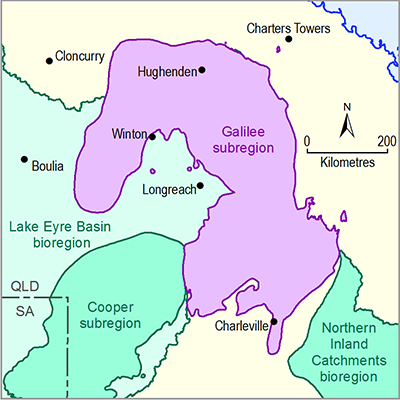- Home
- Assessments
- Bioregional Assessment Program
- Galilee subregion
- 2.6.2 Groundwater numerical modelling for the Galilee subregion
- 2.6.2.9 Limitations and conclusions
The hydrological change due to additional coal resource development in the Galilee subregion is probabilistically estimated with a groundwater analytic element model (GW AEM). It provides the change in drawdown in the upper Permian coal measures, the Clematis Group and the Cenozoic and alluvial sediments as well as the change in the surface water – groundwater flux that is integrated in the Australian Water Resources Assessment landscape (AWRA-L) surface water model, which is reported in companion product 2.6.1 for the Galilee subregion (Karim et al., 2018).
Drawdown in the upper Permian coal measures extends far into the Galilee Basin, with probabilities of exceeding 5 m drawdown in excess of 30% at places 50 km west of the coal mines. The Rewan Group aquitard provides a regional seal that prevents this drawdown to propagate upwards into the overlying Clematis Group and Eromanga Basin.
Simulated drawdowns in the Clematis Group and Cenozoic cover and alluvial sediments are controlled by the direct extraction of water from the Cenozoic and to a much lesser extent by the extraction of water from the upper Permian coal measures. From a distance of about 25 km from the edge of the mine footprints, the probability of exceeding 0.2 m drawdown decreases to less than 5%.
The simulated change in surface water – groundwater flux includes the change in baseflow to the Belyando River and the evapotranspiration by riparian vegetation. The maximum additional change is less than 1% of the baseflow for the Belyando River, estimated in companion product 2.1-2.2 for the Galilee subregion (Evans et al., 2018).
The greatest potential in reducing the predictive uncertainty lies in improved characterisation of the surface water – groundwater interaction in the subregion and the Cenozoic and alluvial aquifer systems. Further development of the numerical MODFLOW model (as outlined in Turvey et al., 2015), including its integration into a probabilistic framework, has great potential to improve the current predictions.

Product Finalisation date
- 2.6.2.1 Methods
- 2.6.2.2 Review of existing models
- 2.6.2.2.1 Alpha and Kevin's Corner model review
- 2.6.2.2.2 Carmichael model review
- 2.6.2.2.3 China First model review
- 2.6.2.2.4 China Stone model review
- 2.6.2.2.5 South Galilee model review
- 2.6.2.2.6 Galilee Basin hydrogeological model review
- 2.6.2.2.7 Suitability of existing groundwater models
- References
- Datasets
- 2.6.2.3 Model development
- 2.6.2.4 Boundary and initial conditions
- 2.6.2.5 Implementation of the coal resource development pathway
- 2.6.2.6 Parameterisation
- 2.6.2.7 Observations and predictions
- 2.6.2.8 Uncertainty analysis
- 2.6.2.9 Limitations and conclusions
- Citation
- Acknowledgements
- Currency of scientific results
- Contributors to the Technical Programme
- About this technical product
